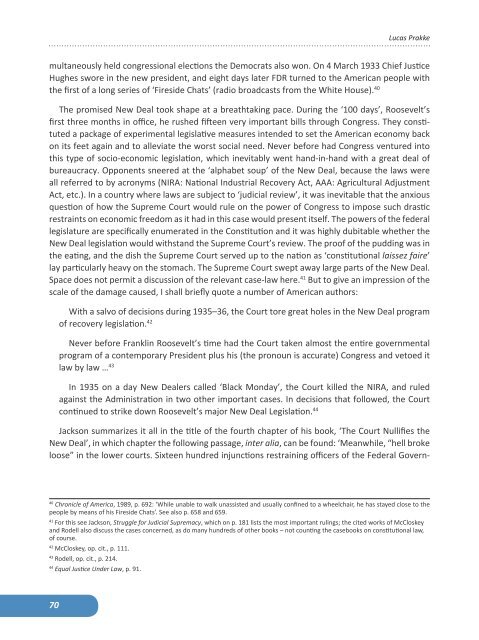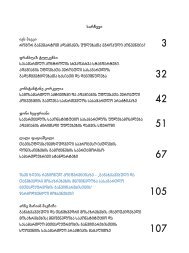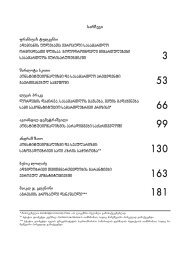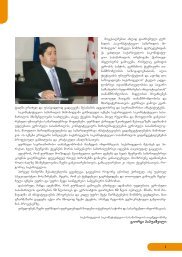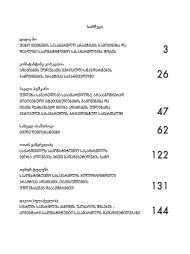Contents - Constitutional Court of Georgia
Contents - Constitutional Court of Georgia
Contents - Constitutional Court of Georgia
You also want an ePaper? Increase the reach of your titles
YUMPU automatically turns print PDFs into web optimized ePapers that Google loves.
70<br />
Lucas Prakke<br />
multaneously held congressional elections the Democrats also won. On 4 March 1933 Chief Justice<br />
Hughes swore in the new president, and eight days later FDR turned to the American people with<br />
the first <strong>of</strong> a long series <strong>of</strong> ‘Fireside Chats’ (radio broadcasts from the White House). 40<br />
The promised New Deal took shape at a breathtaking pace. During the ‘100 days’, Roosevelt’s<br />
first three months in <strong>of</strong>fice, he rushed fifteen very important bills through Congress. They constituted<br />
a package <strong>of</strong> experimental legislative measures intended to set the American economy back<br />
on its feet again and to alleviate the worst social need. Never before had Congress ventured into<br />
this type <strong>of</strong> socio-economic legislation, which inevitably went hand-in-hand with a great deal <strong>of</strong><br />
bureaucracy. Opponents sneered at the ‘alphabet soup’ <strong>of</strong> the New Deal, because the laws were<br />
all referred to by acronyms (NIRA: National Industrial Recovery Act, AAA: Agricultural Adjustment<br />
Act, etc.). In a country where laws are subject to ‘judicial review’, it was inevitable that the anxious<br />
question <strong>of</strong> how the Supreme <strong>Court</strong> would rule on the power <strong>of</strong> Congress to impose such drastic<br />
restraints on economic freedom as it had in this case would present itself. The powers <strong>of</strong> the federal<br />
legislature are specifically enumerated in the Constitution and it was highly dubitable whether the<br />
New Deal legislation would withstand the Supreme <strong>Court</strong>’s review. The pro<strong>of</strong> <strong>of</strong> the pudding was in<br />
the eating, and the dish the Supreme <strong>Court</strong> served up to the nation as ‘constitutional laissez faire’<br />
lay particularly heavy on the stomach. The Supreme <strong>Court</strong> swept away large parts <strong>of</strong> the New Deal.<br />
Space does not permit a discussion <strong>of</strong> the relevant case-law here. 41 But to give an impression <strong>of</strong> the<br />
scale <strong>of</strong> the damage caused, I shall briefly quote a number <strong>of</strong> American authors:<br />
With a salvo <strong>of</strong> decisions during 1935–36, the <strong>Court</strong> tore great holes in the New Deal program<br />
<strong>of</strong> recovery legislation. 42<br />
Never before Franklin Roosevelt’s time had the <strong>Court</strong> taken almost the entire governmental<br />
program <strong>of</strong> a contemporary President plus his (the pronoun is accurate) Congress and vetoed it<br />
law by law … 43<br />
In 1935 on a day New Dealers called ‘Black Monday’, the <strong>Court</strong> killed the NIRA, and ruled<br />
against the Administration in two other important cases. In decisions that followed, the <strong>Court</strong><br />
continued to strike down Roosevelt’s major New Deal Legislation. 44<br />
Jackson summarizes it all in the title <strong>of</strong> the fourth chapter <strong>of</strong> his book, ‘The <strong>Court</strong> Nullifies the<br />
New Deal’, in which chapter the following passage, inter alia, can be found: ‘Meanwhile, “hell broke<br />
loose” in the lower courts. Sixteen hundred injunctions restraining <strong>of</strong>ficers <strong>of</strong> the Federal Govern-<br />
40 Chronicle <strong>of</strong> America, 1989, p. 692: ‘While unable to walk unassisted and usually confined to a wheelchair, he has stayed close to the<br />
people by means <strong>of</strong> his Fireside Chats’. See also p. 658 and 659.<br />
41 For this see Jackson, Struggle for Judicial Supremacy, which on p. 181 lists the most important rulings; the cited works <strong>of</strong> McCloskey<br />
and Rodell also discuss the cases concerned, as do many hundreds <strong>of</strong> other books – not counting the casebooks on constitutional law,<br />
<strong>of</strong> course.<br />
42 McCloskey, op. cit., p. 111.<br />
43 Rodell, op. cit., p. 214.<br />
44 Equal Justice Under Law, p. 91.


